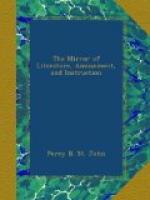The Engraving scarcely requires further explanation. The Royal Procession to the Convent in the distance, with the young King, Edward VI. beneath a canopy, has a picturesque, if not imposing effect. By the way, a Correspondent, who appears to delight in the quaint sublime, tells us that in digging the foundation of the Market just erected in Covent Garden, a quantity of human bones were dug from a rich black mould, at the depth of five feet from the surface, opposite James-street. “The Irish labourers threw them forth, and the sun again gleamed upon the probable particles of holy nuns, till the heavy feet of costermongers, &c. scattered them, and carried the crumbling relics sticking to their muddy heels, throughout the town. This northern portion of the market might probably have been the Convent burial-ground.”
A general descriptive outline of the Strand will assist the second view. Malcolm tells us that “the Strand once consisted of palaces for the Monarch, Archbishop, Bishops, a Royal Hospital, and mansions of the nobility. Yet a complaint occurs in the rolls of parliament of the high road between the Temple and the village of Charing being so deep and miry as to be almost impassable.” Mr. Brayley, in his interesting Londiniana, gives the following:—
“In ancient times the STRAND was an open space, extending from Temple Bar to the village of Charing, sloping down to the river, and intersected by several streams from the neighbouring high grounds, which in this direction emptied themselves into the Thames. In after ages, when the residence of the court at Westminster had become more frequent, and the Parliament was held there, the Strand, being the road thence from the City, became the site of several magnificent mansions belonging to the nobility and clergy, most of which were situated on the south side, and had large gardens extending to the water’s edge.
“The first of these mansions from Temple Bar, was Exeter House, an inn belonging to the Bishops of Exeter, afterwards called Paget House, and Leicester House, and finally Essex House, from being the residence of the favourite of Queen Elizabeth; under the latter appellation it has given name to the street, now built upon the spot where it formerly stood. Between that mansion and the present Milford Lane, was a Chapel, dedicated to the Holy Ghost, called St. Spirit, ’vpon what occasion founded,’ says Stow, ’I have not read.’[2] To the west of this chapel was an Inn, belonging to the Bishop of Bath, called Hampton Place, and afterwards Arundel House, standing on the site of the present Arundel Street.—Further to the westward was an Inn of Chancery, called Chester’s Inn, and Strand Inn, near which the Bishop of Landaff had also an Inn. At a short distance from the latter place was the Strand Bridge; ‘and vnder it,’ says Stow, ’a lane or way down to the landing-place on the




